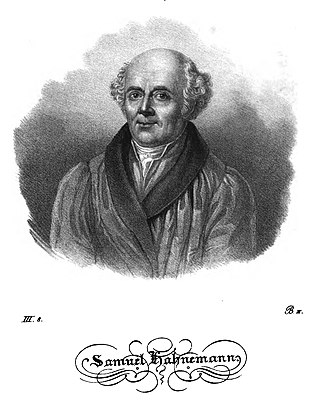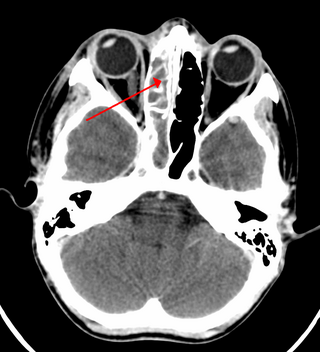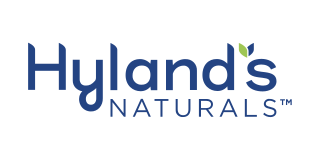Related Research Articles

Homeopathy or homoeopathy is a pseudoscientific system of alternative medicine. It was conceived in 1796 by the German physician Samuel Hahnemann. Its practitioners, called homeopaths or homeopathic physicians, believe that a substance that causes symptoms of a disease in healthy people can cure similar symptoms in sick people; this doctrine is called similia similibus curentur, or "like cures like". Homeopathic preparations are termed remedies and are made using homeopathic dilution. In this process, the selected substance is repeatedly diluted until the final product is chemically indistinguishable from the diluent. Often not even a single molecule of the original substance can be expected to remain in the product. Between each dilution homeopaths may hit and/or shake the product, claiming this makes the diluent "remember" the original substance after its removal. Practitioners claim that such preparations, upon oral intake, can treat or cure disease.

Sinusitis, also known as rhinosinusitis, is an inflammation of the mucous membranes that line the sinuses resulting in symptoms that may include thick nasal mucus, a plugged nose, and facial pain.

Anosmia, also known as smell blindness, is the loss of the ability to detect one or more smells. Anosmia may be temporary or permanent. It differs from hyposmia, which is a decreased sensitivity to some or all smells.

The common cold or the cold is a viral infectious disease of the upper respiratory tract that primarily affects the respiratory mucosa of the nose, throat, sinuses, and larynx. Signs and symptoms may appear fewer than two days after exposure to the virus. These may include coughing, sore throat, runny nose, sneezing, headache, and fever. People usually recover in seven to ten days, but some symptoms may last up to three weeks. Occasionally, those with other health problems may develop pneumonia.

Over-the-counter (OTC) drugs are medicines sold directly to a consumer without a requirement for a prescription from a healthcare professional, as opposed to prescription drugs, which may be supplied only to consumers possessing a valid prescription. In many countries, OTC drugs are selected by a regulatory agency to ensure that they contain ingredients that are safe and effective when used without a physician's care. OTC drugs are usually regulated according to their active pharmaceutical ingredient (API) rather than final products. By regulating APIs instead of specific drug formulations, governments allow manufacturers the freedom to formulate ingredients, or combinations of ingredients, into proprietary mixtures.

Xylometazoline, also spelled xylomethazoline, is a medication used to reduce symptoms of nasal congestion, allergic rhinitis, and sinusitis. Use is not recommended for more than seven days. Use is also not recommended in those less than three months of age and some say not less than 6 years of age. It is used directly in the nose as a spray or drops.

Cold medicines are a group of medications taken individually or in combination as a treatment for the symptoms of the common cold and similar conditions of the upper respiratory tract. The term encompasses a broad array of drugs, including analgesics, antihistamines and decongestants, among many others. It also includes drugs which are marketed as cough suppressants or antitussives, but their effectiveness in reducing cough symptoms is unclear or minimal.
A decongestant, or nasal decongestant, is a type of pharmaceutical drug that is used to relieve nasal congestion in the upper respiratory tract. The active ingredient in most decongestants is either pseudoephedrine or phenylephrine. Intranasal corticosteroids can also be used as decongestants and antihistamines can be used to alleviate runny nose, nasal itch, and sneezing.

Benadryl is a brand of various antihistamine medications used to stop allergies, whose content varies in different countries, but which includes some combination of diphenhydramine, acrivastine, and/or cetirizine.

Konjac and konnyaku are common names of Amorphophallus konjac, a vegetable species native to Yunnan in southwest China which has an edible corm. It is also known as konjaku, konnyaku potato, devil's tongue, voodoo lily, snake palm, or elephant yam.
Actifed is a registered trademark for a combination antihistamine and nasal decongestant medication used for cold and allergy symptoms. Actifed was developed in 1958 by Burroughs Wellcome & Company, later Haleon.

Zinc gluconate is the zinc salt of gluconic acid. It is an ionic compound consisting of two anions of gluconate for each zinc(II) cation. Zinc gluconate is a popular form for the delivery of zinc as a dietary supplement providing 14.35% elemental zinc by weight.

Azelastine, sold under the brand name Optivar among others, is a H1 receptor-blocking medication primarily used as a nasal spray to treat allergic rhinitis (hay fever) and as eye drops for allergic conjunctivitis. Other uses may include asthma and skin rashes for which it is taken by mouth. Onset of effects is within minutes when used in the eyes and within an hour when used in the nose. Effects last for up to 12 hours.

Heel is a developer, producer and distributor of homeopathic preparations. It was founded in 1936 by Hans-Heinrich Reckeweg. Heel has offices in 40 countries worldwide including the United States where it is located in Albuquerque, NM.

Homeopathy is fairly common in some countries while being uncommon in others. In some countries, there are no specific legal regulations concerning the use of homeopathy, while in others, licenses or degrees in conventional medicine from accredited universities are required.

Charles B. Hensley is an American businessman. In 1997 he invented and developed Zicam, a homeopathic patent medicine for the common cold.
Matrixx Initiatives, Inc. v. Siracusano, 563 U.S. 27 (2011), is a decision by the Supreme Court of the United States regarding whether a plaintiff can state a claim for securities fraud under §10(b) of the Securities Exchange Act of 1934, as amended, 15 U.S.C. §78j(b), and Securities and Exchange Commission Rule 10b-5, 17 CFR §240.10b-5 (2010), based on a pharmaceutical company's failure to disclose reports of adverse events associated with a product if the reports do not find statistically significant evidence that the adverse effects may be caused by the use of the product. In a 9–0 opinion delivered by Justice Sonia Sotomayor, the Court affirmed the Court of Appeals for the Ninth Circuit's ruling that the respondents, plaintiffs in a securities fraud class action against Matrixx Initiatives, Inc., and three Matrixx executives, had stated a claim under §10(b) and Rule 10b-5.

Zinc supplements are a group of dietary supplements that are commonly used for the treatment of the common cold. The use of zinc supplements at doses in excess of 75 mg/day within 24 hours of the onset of symptoms has been shown to reduce the duration of cold symptoms by about 1 day in adults. Adverse effects with zinc supplements by mouth include bad taste and nausea. The intranasal use of zinc-containing nasal sprays has been associated with the loss of the sense of smell; consequently, in June 2009, the United States Food and Drug Administration (USFDA) warned consumers to stop using intranasal zinc.

Hyland's is a brand of homeopathic products sold in the United States and Canada. Hyland's operates in the United States as Hyland's Inc and in Canada as Hyland's Homeopathic Canada Inc and is a division of Standard Homeopathic Co..
The infinitesimally low concentration of homeopathic preparations, which often lack even a single molecule of the diluted substance, has been the basis of questions about the effects of the preparations since the 19th century. Modern advocates of homeopathy have proposed a concept of "water memory", according to which water "remembers" the substances mixed in it, and transmits the effect of those substances when consumed. This concept is inconsistent with the current understanding of matter, and water memory has never been demonstrated to exist, in terms of any detectable effect, biological or otherwise.
References
- ↑ Our Story
- 1 2 Zicam: Label data, National Institutes of Health
- ↑ Salzberg, Steven. "The Top Five Cold Remedies That Do Not Work". Forbes. Retrieved November 21, 2019.
- ↑ "Cold-Shortening Products: Are They Worth It?". Reviews.com. February 26, 2019. Retrieved November 21, 2019.[ permanent dead link ]
- ↑ "Matrixx Corporate Page". Archived from the original on August 28, 2010. Retrieved April 30, 2009.
- ↑ Gorman, Christine (November 15, 1999). "Block That Cold!". Time . Archived from the original on June 22, 2009.
- 1 2 3 Harris, Gardinier (June 16, 2009). "FDA Warns Against Use of Zicam". New York Times.
- ↑ Bruce W. Jafek; Miriam R. Linschoten; Bruce W. Murrow (May–June 2004). "Anosmia after Intranasal Zinc Gluconate Use". American Journal of Rhinology. 18 (3): 137–141. doi:10.1177/194589240401800302. PMID 15283486. S2CID 12554540.
- ↑ "Nasal spray can cause loss of smell, FDA warns". NBC News. Associated Press. June 16, 2009. Retrieved October 16, 2014.
- ↑ Hirt, M; Nobel, S; Barron, E (October 2000). "Zinc nasal gel for the treatment of common cold symptoms: a double-blind, placebo-controlled trial". Ear, Nose, & Throat Journal. 79 (10): 778–780, 782. doi: 10.1177/014556130007901008 . PMID 11055098. S2CID 20317285.
- ↑ Mossad, S.B. (January 1, 2003). "Effect of zincum gluconicum nasal gel on the duration and symptom severity of the common cold in otherwise healthy adults". QJM. 96 (1): 35–43. doi: 10.1093/qjmed/hcg004 . PMID 12509647 . Retrieved August 1, 2014.
- ↑ Teut, Michael; Dahler, Jörn; Schnegg, Christoph (2008). "A Homoeopathic Proving of Galphimia glauca". Forschende Komplementärmedizin. 15 (4): 211–217. doi:10.1159/000148825. PMID 18787330. S2CID 39667178.
- ↑ Description of Histaminum Hydrochloricum
- ↑ Luffa operculata L. COGN Sponge Cucumber Archived December 3, 2013, at the Wayback Machine
- ↑ "Homeopathic medicine company fights off Zicam lawsuits". USA Today. August 1, 2007.
- ↑ See Siracusano v. Matrixx Initiatives, Inc., 585 F.3d 1167, 1169 (2009).
- ↑ No. 09-1156 (U.S. Mar. 22, 2011) (slip op.).
- ↑ "Court Documents | Melgar v. Zicam LLC and Matrixx Initiatives, Inc".
- 1 2 "NAD Recommends Matrixx Discontinue Claims that Suggest ‘Zicam’ Products Protect Users from Catching Cold; Found Advertiser Could Support Certain Claims". Advertising Self-Regulatory Council, April 5, 2013.
- 1 2 "FDA Advises Consumers Not To Use Certain Zicam Cold Remedies: Intranasal Zinc Product Linked to Loss of Sense of Smell". U.S. Food and Drug Administration. June 16, 2009.
- 1 2 "Zicam Fact Sheet". U.S. Food and Drug Administration. June 16, 2009. Retrieved June 20, 2009.
- ↑ Matrixx Said It Didn’t Give 800 Zicam Reports to FDA (Update1)
- 1 2 3 4 Autor, Deborah M. (June 16, 2009). "Warning Letter, FDA Director of Compliance to Matrixx Initiatives, Inc. AKA Zicam LLC". Food and Drug Administration.
- ↑ Des Moines Register, June 20, 2009, page 16A.[ full citation needed ]
- ↑ F.D.A. Warns Against Use of Popular Cold Remedy, New York Times, June 16, 2009
- 1 2 "Matrixx Initiatives Voluntarily Withdraws Zicam Cold Remedy Swabs, Zicam Cold Remedy Nasal Gel". Matrixx Corporation. June 16, 2009.
- 1 2 "Matrixx recalls Zicam nasal cold products". Associated Press. June 24, 2009. Archived from the original on June 27, 2009.
- ↑ Matrixx again asks FDA to rescind Zicam warning, Matrixx Initiatives, in The Arizona Republic , November 19, 2009
- ↑ Zicam Cold Remedy Nasal Gel, Zicam Cold Remedy Swabs, and Zicam Cold Remedy Swabs, Kids Size – Foreign Product Alert